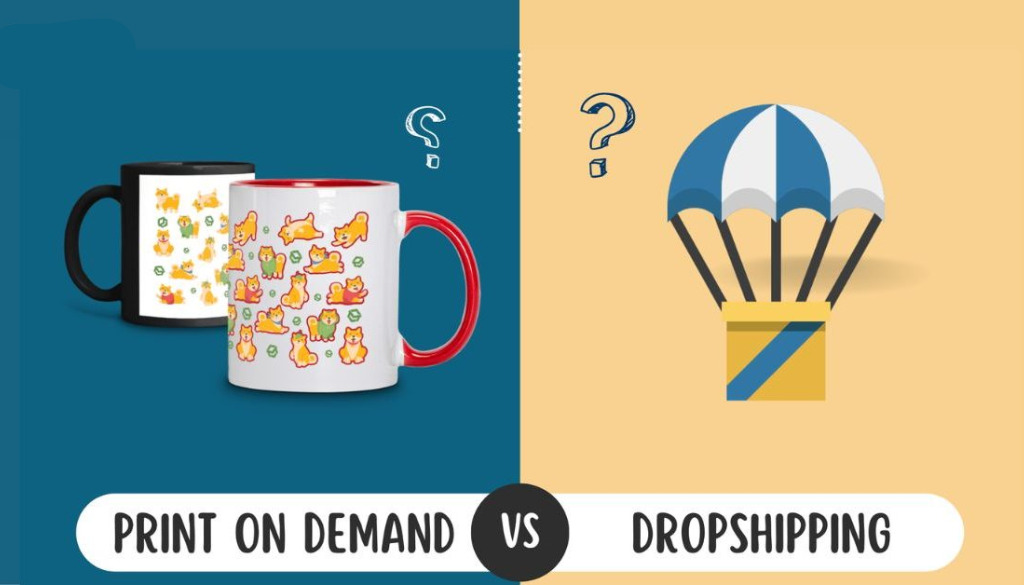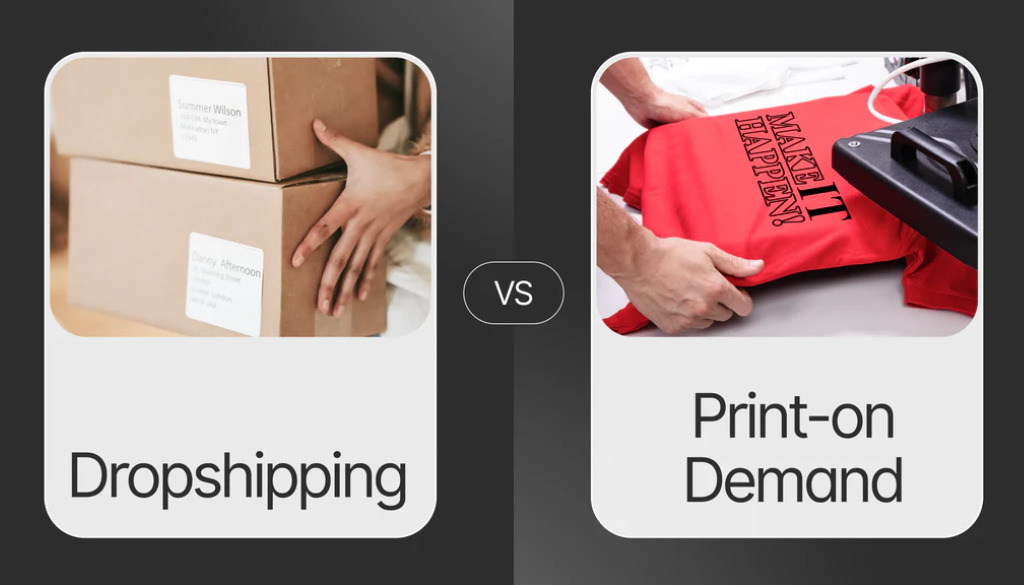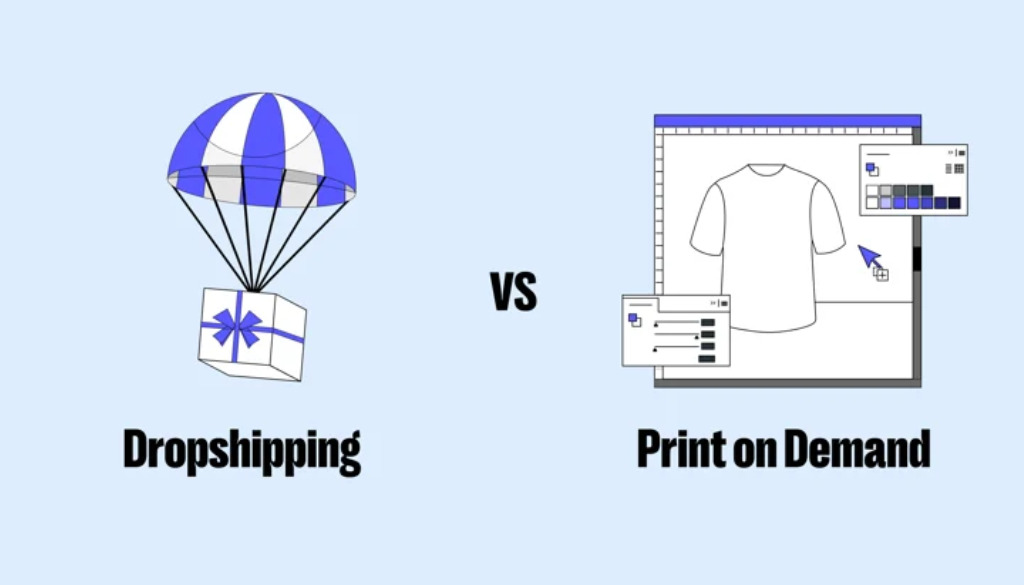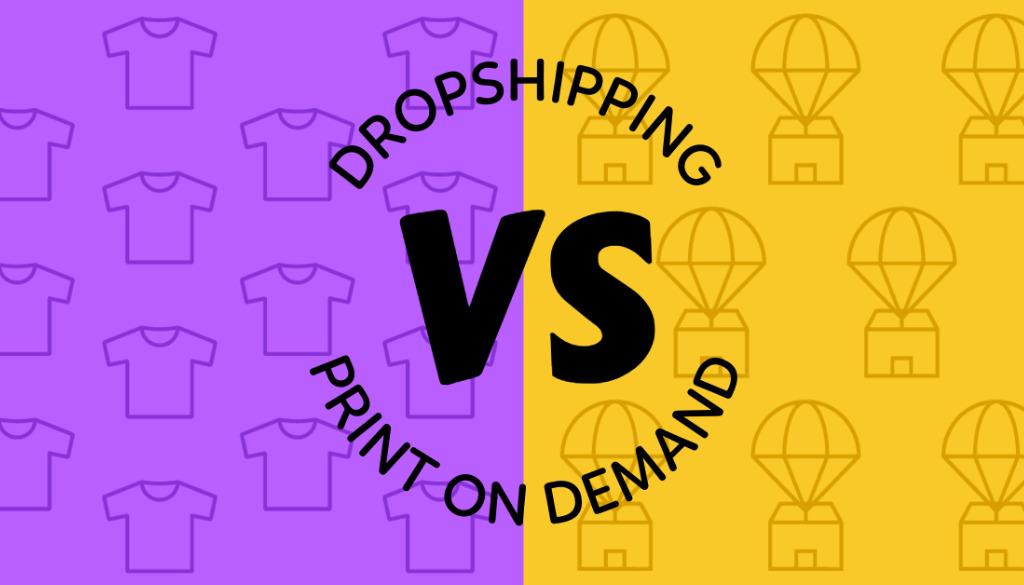In the world of MMO (Make Money Online) business, Print on demand vs Dropshipping are two popular models that help sellers build online stores without worrying about inventory or manufacturing. While each model offers pros and cons, the question remains: which best fits your needs? This article will help you compare the two models in detail, enabling you to make an informed decision to optimize profits and sustainably grow your business.
Overview of the Two Business Models
Before diving into a detailed comparison, let’s clearly define the essence of each model.

1. POD Model
Definition
Print on Demand (POD) is an e-commerce business model where the seller collaborates with a supplier (fulfillment partner) to customize “blank” products (white-label products) with their own designs and sell them under their brand.
The key feature of POD is that products are only created once a customer places an order. This means you don’t pay for the product until it’s sold. This eliminates the need for inventory, and there’s no risk of upfront capital investment in products.
The POD process works as follows:
- Step 1: Design – You create unique designs (images, slogans, logos, etc.) to be printed on products.
- Step 2: Create Mockups & List for Sale – You use the POD provider’s tools to create product mockups and list them on your online store (e.g., Shopify, Etsy, Amazon, etc.).
- Step 3: Customer Order – A customer visits your store, loves your design, and decides to purchase an item, paying the retail price you’ve listed.
- Step 4: Automatic Processing – The order is automatically sent to the POD provider’s system.
- Step 5: Printing & Fulfillment – The POD provider takes a blank product (e.g., a t-shirt) from their inventory, prints your design on it, packages the product (often with the option to customize labels and packaging with your brand), and ships it directly to the customer.
- Step 6: Profit – You pay the POD provider the base cost for the product and services such as printing and shipping. The difference between the retail price and the base cost is your profit.
Examples of Popular print-on-demand items: T-shirts, hoodies, mugs, phone cases, canvas prints, posters, tote bags, hats, notebooks, etc.
2. Dropshipping Model
Definition
Dropshipping is another business model where the seller does not keep inventory. Instead, when a store sells a product using this model, they purchase the item from a third-party supplier (manufacturer, wholesaler, or another retailer) and have them ship it directly to the customer.
Similar to POD, the seller does not handle the product directly. The main difference is that dropshipping products are pre-made items, not customized products based on a unique design.
The Detailed Process of Dropshipping:
- Step 1: Research & Choose Products – You research the market, look for “hot trend” products or potential niche markets from suppliers (often on platforms like AliExpress, CJ Dropshipping, Spocket, etc.).
- Step 2: List Products for Sale – You take images and product descriptions from the supplier and list them for sale in your store at a higher price.
- Step 3: Customer Order – A customer purchases the product from your store and makes a payment.
- Step 4: Forward the Order – You receive the order and customer details. You then place the order for the product with your supplier and provide them with the customer’s shipping information.
- Step 5: Supplier Ships – The supplier packages and ships the product directly to your customer.
- Step 6: Profit – Your profit is the difference between the amount the customer pays you and the amount you pay the supplier.
Examples of Successful Dropshipping Niches: Smart home appliances, pet accessories, home gym equipment, unique kitchenware, jewelry, etc.
Detailed Comparison Between Print on demand vs Dropshipping

Now, let’s put these two models on the scale and directly compare them based on the most important criteria for an online seller.
1. Product Source and Products
Print on Demand (POD):
- Advantages: You create a unique product. The core value lies in your design. You’re not just selling a t-shirt; you’re selling a piece of art, a message, or a part of a brand that customers can wear. This naturally creates a competitive barrier.
- Disadvantages: The product range is limited to what your POD supplier offers. You can only print on items like t-shirts, mugs, hats, etc., that they provide. Finding a supplier with a wide range of high-quality products that meet your expectations can be challenging.
Dropshipping:
- Advantages: The variety of products is almost limitless. You can sell anything, from electronics, fashion, home goods, to the most niche products. It’s easy to test different products to see what works, without being confined to a specific category.
- Disadvantages: Since you’re selling pre-existing products, it’s likely that dozens, even hundreds, of other competitors are selling the exact same product. The only differentiation often lies in price and marketing strategy.
If your strength is creativity and you want to sell something “of your own,” POD is the superior choice. However, if you’re good at spotting trends and analyzing data to identify best-selling products, Dropshipping offers the flexibility you need.
2. Customization and Branding
This is the biggest and most important difference between the two models.
Print on Demand (POD):
The King of Branding. The entire POD model is built around your brand. Every product sold carries your creative stamp. Customers purchase because they love your style, message, and brand story. You can build a truly loyal customer community. Many POD suppliers even allow you to customize labels, thank-you cards, packaging, and create an “unboxing” experience that is entirely branded.
For example, a successful POD brand doesn’t just sell t-shirts with pictures of cats and dogs; they build a community for animal lovers, share stories, and create designs that resonate emotionally with that target audience.
Dropshipping:
A major challenge for branding. The products you sell are from other suppliers. The packaging is often generic, unbranded, or worse, carrying the supplier’s logo from China. Building a memorable brand when your products aren’t unique is incredibly difficult. Your brand is primarily represented through marketing, website design, and customer service, not the product itself. Some larger suppliers offer custom packaging services, but these usually come with high costs and minimum order requirements.
If your long-term goal is to build a sustainable, valuable brand that could be sold in the future, POD is the clearer path. If your focus is on making quick profits from trending products, Dropshipping might meet that goal.
3. Profit Margins

Print on Demand (POD):
Typically lower at the basic level. The base cost of a POD product is usually higher than a similar item in dropshipping. This is because the cost includes the blank product, printing services, and individual order handling. Therefore, to achieve good profit margins, you need to price your products higher, which requires your design to be truly valuable, and your brand to be strong enough to convince customers.
However, because the product is exclusive, you are less likely to get caught in a price war. You have the freedom to price based on the perceived value of the design.
Dropshipping:
Has a higher potential. Because you source products directly from manufacturers or wholesalers in bulk (even though you buy in smaller quantities), the cost of goods can be very cheap. This allows for a higher potential profit margin on each product.
However, “potential” is the key word here. Due to fierce competition, many dropshipping sellers are forced to reduce prices to attract customers, which severely erodes profit margins. Actual profit depends heavily on your ability to find low-cost suppliers and your marketing skills to sell products without deep discounting.
While dropshipping may offer higher paper profits, POD provides more stable and predictable profits because you control the exclusivity factor.
4. Fulfillment and Shipping Management
Print on Demand (POD):
- Longer Processing Time: Products need time to be printed (usually 1-3 business days) before they can be shipped. This results in a longer total shipping time compared to simply picking a ready-to-ship product from the shelf. It’s essential to communicate this timeline clearly to customers to avoid disappointment.
- Focused Partnering: You typically work with one or a few POD suppliers. This simplifies management, but it also creates risks if the supplier faces quality issues or runs out of stock.
Dropshipping:
- Shipping Time is the Achilles’ Heel: Many dropshipping products come from China. Although shipping methods like ePacket exist, delivery times can still take 2-4 weeks or even longer. In the age of Amazon Prime, this is a significant disadvantage and a primary cause of customer complaints.
- Complex Management: You may work with multiple suppliers for different products. If a customer orders 3 products from 3 different suppliers, they will receive 3 separate packages at 3 different times, increasing shipping costs and providing a poor customer experience.
Both models outsource fulfillment to third parties. With POD, the challenge lies in production time, while with dropshipping, the challenge is shipping time and the complexity of dealing with multiple suppliers. Regardless of the model you choose, partnering with a reliable fulfillment partner, transparent communication, and a professional order tracking system, like FlashShip, is crucial to ensuring customer satisfaction.
5. Competition and Market Saturation
Print on Demand (POD):
- Competition at the design and branding level: The market can be crowded, but you are not directly competing with others on the same product. Instead, you compete for the attention of the same target audience. The barrier to entry is the ability to create appealing designs and build a compelling brand story.
- Hard to Copy: A competitor can copy a design, but they cannot replicate your entire brand, credibility, and community that you have built.
Dropshipping:
- Direct and fierce competition: When a winning product is found, it is quickly copied by hundreds of other sellers. Everyone sells the same item from the same supplier with the same images. The battle takes place on the advertising front (who can optimize Facebook/TikTok ads better) and on price.
- Low barrier to entry: Anyone can find a product on AliExpress and start running ads within a few hours. This leads to a highly saturated market, and the lifecycle of a “hot” product is often very short.
POD offers a more sustainable playing field, where creativity is rewarded. Dropshipping is like a sprint, requiring speed, agility, and continuous optimization to survive.
Which model should you choose? Print on Demand or Dropshipping?

There is no absolute “right” or “wrong” answer. The best choice depends entirely on your skills, preferences, goals, and resources. Here are some suggestions to guide you:
Choose Print on Demand if you:
- Are a creative person: You’re an artist, graphic designer, humorist, or simply someone with many unique ideas you want to express. Your strength is in creating something new.
- Want to build a sustainable brand: You have a long-term vision for creating a valuable name, a loyal community, and a real business asset. You are not afraid to invest time and effort into nurturing your brand image.
- Want to sell exclusive products: You want to offer customers products they can’t find anywhere else. Uniqueness is your core competitive advantage.
- Prioritize product differentiation over price competition: You’re confident that your design is good enough for customers to be willing to pay a little more for a personalized and unique product.
Choose Dropshipping if you:
- Are a skilled marketer and data analyst: Your strength is not in creating products but in finding, analyzing, and selling them. You excel at market research, trend tracking, running ads, and optimizing conversion rates.
- Want to experiment quickly and flexibly: You want the ability to launch and test dozens of different products in a short amount of time to find a “gold mine.” You don’t want to be confined to a specific product category.
- Lack skills or passion for design: The thought of creating each product design yourself feels exhausting. You prefer searching for and managing existing products.
- Are ready for a highly competitive environment: You understand that you’ll face many competitors and are prepared to engage in the battle of optimizing ads and finding effective suppliers.
Alternative Approach: Hybrid Model
Why choose one when you can have both? A smart business strategy that many successful sellers are adopting is combining both POD and Dropshipping<./b>
- Build a foundation with POD: Use Print on Demand to create core products that carry your brand’s signature. These are the products that help you build a community, differentiate yourself, and maintain stable profit margins. For example, a store selling products for yoga enthusiasts might offer exclusive meditation-themed t-shirts and yoga mats.
- Expand your product range with Dropshipping: Use Dropshipping to add related products to your store without customization. Continuing with the previous example, the store could dropship yoga blocks, resistance bands, water bottles, etc., from trusted suppliers.
This approach allows you to leverage the best of both worlds: the uniqueness and brand strength of POD, combined with the variety and flexibility of Dropshipping.
Both Print on Demand and Dropshipping are great gateways into the e-commerce world. Neither model is “better” in an absolute sense; there is only the “better fit” for you.
- POD is a marathon, focused on building brand value and creativity.
- Dropshipping is a sprint, focused on capturing trends and optimizing marketing.
Take time to honestly assess your strengths, weaknesses, and passions. Are you an artist or an analyst? Do you want to create a lasting brand legacy, or are you looking to maximize profits in the short term?
No matter which path you choose, Print on Demand or Dropshipping, one factor will never change: the importance of providing the best possible experience for your customers. This includes product quality and, equally important, the fulfillment and shipping process. A reliable, transparent, and efficient fulfillment partner like FlashShip will always be a strong foundation, helping you confidently build and grow your online store, regardless of the business model you choose. Visit: https://seller.flashship.net or contact the hotline (+84) 943 024 337 for detailed consultation and account creation support.

